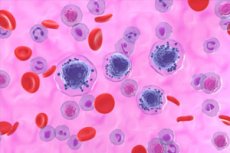Nye publikasjoner
Barneleukemi kan oppstå under fosterutviklingen
Sist anmeldt: 02.07.2025

Alt iLive-innhold blir gjennomgått med medisin eller faktisk kontrollert for å sikre så mye faktuell nøyaktighet som mulig.
Vi har strenge retningslinjer for innkjøp og kun kobling til anerkjente medieområder, akademiske forskningsinstitusjoner og, når det er mulig, medisinsk peer-evaluerte studier. Merk at tallene i parenteser ([1], [2], etc.) er klikkbare koblinger til disse studiene.
Hvis du føler at noe av innholdet vårt er unøyaktig, utdatert eller ellers tvilsomt, velg det og trykk Ctrl + Enter.

Et forskerteam har vist at noen leukemier hos barn starter under embryonal utvikling, selv om de ikke blir tydelige før flere måneder etter fødselen.
Teamet inkluderer forskere fra Institutt for onkologi ved Universitetet i Oviedo (IUOPA), Josep Carreras leukemiforskningsinstitutt, Universitetet i Barcelona og Senter for biomedisinsk forskning på kreft (CIBERONC). Studien er publisert i tidsskriftet Leukemia.
Akutt myelogen leukemi er den nest vanligste typen akutt leukemi hos barn og kan diagnostiseres i løpet av de første månedene av livet. Den tidlige sykdomsutbruddet har ført til mistanke om at svulsten kan ha en prenatal opprinnelse. Det har imidlertid vært vanskelig å bevise denne teorien på grunn av mangelen på prenatale eller fødselsprøver.
«Muligheten til å studere opprinnelsen til denne leukemien oppsto takket være tilfellet med en 5 måneder gammel baby som ble diagnostisert med akutt myeloid leukemi ved Niño Jesús-sykehuset i Madrid», forklarer Pablo Menéndez, professor ved ICREA ved Universitetet i Barcelona og Josep Carreras-instituttet. «Foreldrene, som reddet navlestrengsblodet, åpnet opp for en forskningslinje som ikke hadde vært mulig før nå.»
Ved hjelp av presisjonsmedisinske teknikker analyserte forskerne hele svulstens genom. I motsetning til svulster hos voksne, hvor tusenvis av mutasjoner finnes, ble det bare funnet to kromosomavvik i denne leukemien.
«Genomisk analyse har gjort det mulig for oss å utvikle en personlig diagnostisk metode for å overvåke sykdommen», sier José S. Puente, professor i biokjemi ved Universitetet i Barcelona. Puente er professor i biokjemi og molekylærbiologi ved Universitetet i Oviedo. «Men disse dataene reiser nye spørsmål, som når svulsten oppsto og i hvilken rekkefølge disse mutasjonene dukket opp», legger han til.
Disse spørsmålene er vanskelige å svare på fordi slike studier krever blodprøver fra spedbarnet før diagnose, noe som ikke er mulig i de aller fleste tilfeller. I dette tilfellet tillot imidlertid eksistensen av en frossen navlestrengsblodprøve forskerne å skille ut de ulike populasjonene av blodceller ved fødselen og studere om noen av de kromosomale abnormalitetene som ble funnet i svulsten allerede var tilstede under fosterutviklingen.
Studien fant at en translokasjon mellom kromosom 7 og 12 allerede var tilstede i noen hematopoietiske stamceller i navlestrengsblodet. I motsetning til dette var en annen kromosomavvik, trisomi 19, ikke tilstede hos fosteret, men ble funnet i alle tumorceller, noe som tyder på at den bidrar til økt malignitet hos leukemiceller.
«Disse dataene er ekstremt viktige for å forstå utviklingen av denne ødeleggende sykdommen, og eksistensen av denne navlestrengsblodprøven var avgjørende for å gjennomføre en studie som ikke hadde vært mulig ved akutt myelogen leukemi frem til nå», legger Thalia Velasco, forsker ved Josep Carreras-instituttet og Universitetet i Barcelona, og medforfatter av studien, til.
I tillegg til å rekonstruere de genomiske endringene som cellene gjennomgår for å forårsake denne leukemien, identifiserte studien også en molekylær mekanisme som ikke tidligere har blitt observert i denne typen leukemi, og som forårsaker aktiveringen av MNX1-genet, som ofte er endret i denne typen svulst.
Kunnskap om disse endringene er nødvendig for å utvikle celle- og dyremodeller som vil gjøre det mulig for oss å forstå sykdommens utvikling og utvikle nye metoder for å behandle disse patologiene.
